Piethorne Reservoir facts for kids
Quick facts for kids Piethorne Reservoir |
|
|---|---|
 |
|
| Location | Greater Manchester |
| Coordinates | 53°36′35″N 2°3′18″W / 53.60972°N 2.05500°W |
| Type | reservoir |
| Primary inflows | Piethorne Brook Cold Greave Brook |
| Primary outflows | Piethorne Brook |
| Basin countries | United Kingdom |
| Max. depth | 22 m (72 ft) |
| Water volume | 344 million imperial gallons (1,270 acre⋅ft) |
Piethorne Reservoir is the biggest of several large reservoirs in the Piethorne Valley. This valley is located above Newhey, near Milnrow, in the Metropolitan Borough of Rochdale, Greater Manchester, England. Workers built the reservoir between 1858 and 1868.
During the digging for Piethorne Reservoir in the mid-1800s, people found an old Celtic spear-head. It had a 5-inch (130 mm) blade. This discovery suggests that people lived in this area a very long time ago, during the Bronze Age.
| Next Reservoir upstream | Piethorne Valley | Next Reservoir downstream |
| Norman Hill Reservoir Hanging Lees Reservoir |
Piethorne Reservoir | Kitcliffe Reservoir |
Contents
Why Piethorne Reservoir Was Built
The town of Oldham grew very quickly. In the 1830s, about 25,000 people lived there. By 1870, this number jumped to 120,000! The town's first two reservoirs and local wells could not provide enough water for everyone. Sometimes, there was only water for a few hours each day.
To solve this problem, Oldham Corporation bought land in the Piethorne Valley. This area was about 8 miles (13 km) from Oldham. They planned to build a big new reservoir there to supply the growing town with fresh water.
How Piethorne Reservoir Was Constructed
Building work on Piethorne Reservoir began in 1858. It took ten years for the reservoir to fill completely for the first time. As workers dug the ground, they found the ancient Celtic spear-head. This was an exciting discovery, showing that people lived here thousands of years ago.
Soon, builders noticed a problem. Silt, which is like fine mud, was washing into the reservoir from the nearby streams. These streams were Piethorne Brook and Cold Greave Brook. To fix this, they built another reservoir called Hanging Lees Reservoir. This new reservoir acted like a giant filter, letting the silt settle before the water reached Piethorne.
Workers built four more reservoirs in the area:
- Kitcliffe and Norman Hill were built in the 1870s.
- Ogden was started in 1878. This reservoir helped make sure mills further down Piethorne Brook still had enough water.
- Rooden Reservoir was built later.
A special stone waterfall, called a cascade, was built to carry water from Norman Hill Reservoir to Piethorne Reservoir. Another stone cascade was made for water overflowing from Ogden Reservoir. Horses were very important during construction. They pulled wagons along special tracks to move heavy materials around the site.
The dams for Piethorne and the other reservoirs were built using a special method. They had a core made of "clay puddle." This clay was packed very tightly to make the dam waterproof. Strong earth material supported this clay core. Workers called "navvies" would stomp on the clay, wearing boots with sacking tied around their legs. They did this until the dam reached its full height.
The "Butty Gang" System
The workers who built the reservoir were called "navvies." This was short for "navigational engineers." They worked in groups called "Butty Gangs." Each gang was paid a set amount for a job. The workers in the gang then divided the money among themselves.
Navvies were known for being very hard-working and strong. They also lived a tough life. Some of them stayed in a long building called the Long Shed at Kitcliffe. An old local woman named Betty Whitehead, who was seventy in 1957, remembered them. She told a newspaper that the navvies "usually had a pocketful of money and a bellyful of beer." People also said they were quite boisterous. Sometimes, arguments and fights happened.
Early Ways to Treat Water
The soil and water from the moorland were, and still are, a bit acidic. This was a problem because acidic water could damage Oldham Corporation's cast iron water pipes. Even before Piethorne Reservoir was completely full, people had to add lime to the water. Lime helps to make the water less acidic.
Around 1866, a stone building called the Lime House was built next to the reservoir. This building was used to store the lime. The Lime House is still there today, even though a modern water treatment plant was built later to clean the water.
Piethorne Reservoir Today
Today, Piethorne Reservoir holds a huge amount of water. It can hold 344 million gallons, which is enough water for about 7 million baths! At its deepest point, the reservoir is 22 meters (72 feet) deep. Its embankments, or sides, are 25 meters (82 feet) high.
The entire area around the reservoir, known as the Piethorne Valley, covers 736 hectares (about 1,819 acres). It's a great place for outdoor activities. You can find walking trails here and even go fishing. It's also a wonderful spot for watching wildlife.
Many different kinds of birds live in the valley, including:
- Curlews
- Meadow pipits
- Wheatears
- Skylarks
- Great crested grebes
Sometimes, you might even spot larger birds like buzzards and peregrine falcons. The area is also home to many mammals and beautiful butterflies.


